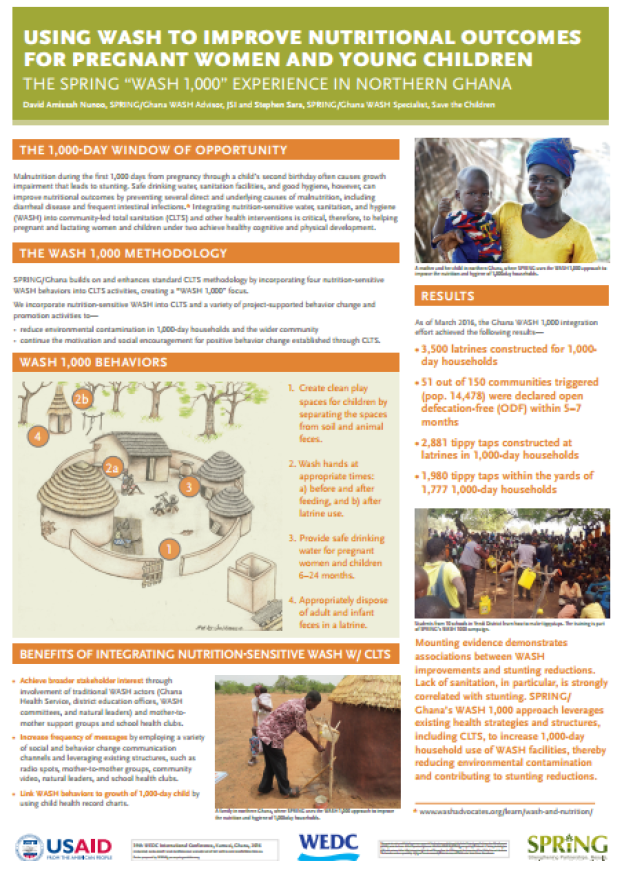Authors: David Amissah Nunoo, SPRING/Ghana WASH Advisor, JSI and Stephen Sara, SPRING/Ghana WASH Specialist, Save the Children
The 1,000 Day Window of Opportunity: Malnutrition during the first 1,000 days from pregnancy through a child’s second birthday often causes growth impairment that leads to stunting. Safe drinking water, sanitation facilities, and good hygiene, however, can improve nutritional outcomes by preventing several direct and underlying causes of malnutrition, including diarrheal disease and frequent intestinal infections.* Integrating nutrition-sensitive water, sanitation, and hygiene (WASH) into community-led total sanitation (CLTS) and other health interventions is critical, therefore, to helping pregnant and lactating women and children under two achieve healthy cognitive and physical development.1
The WASH 1,000 Methodology: SPRING/Ghana builds on and enhances standard CLTS methodology by incorporating four nutrition-sensitive WASH behaviors into CLTS activities, creating a “WASH 1,000” focus.
We incorporate nutrition-sensitive WASH into CLTS and a variety of project-supported behavior change and promotion activities to—
- reduce environmental contamination in 1,000-day households and the wider community
- continue the motivation and social encouragement for positive behavior change established through CLTS.
- Create clean play spaces for children by separating the spaces from soil and animal feces.
- Wash hands at appropriate times: a) before and after feeding, and b) after latrine use.
- Provide safe drinking water for pregnant women and children 6–24 months.
- Appropriately dispose of adult and infant feces in a latrine.
Benefits Of Integrating Nutrition-Sensitive WASH with CLTS:
- Achieve broader stakeholder interest through involvement of traditional WASH actors (Ghana Health Service, district education offices, WASH committees, and natural leaders) and mother-tomother support groups and school health clubs.
- Increase frequency of messages by employing a variety of social and behavior change communication channels and leveraging existing structures, such as radio spots, mother-to-mother groups, community video, natural leaders, and school health clubs.
- Link WASH behaviors to growth of 1,000-day child by using child health record charts.
Results:
As of March 2016, the Ghana WASH 1,000 integration effort achieved the following results—
- 3,500 latrines constructed for 1,000- day households
- 51 out of 150 communities triggered (pop. 14,478) were declared open defecation-free (ODF) within 5–7 months
- 2,881 tippy taps constructed at latrines in 1,000-day households
- 1,980 tippy taps within the yards of 1,777 1,000-day households
Conclusion: Mounting evidence demonstrates associations between WASH improvements and stunting reductions. Lack of sanitation, in particular, is strongly correlated with stunting. SPRING/ Ghana’s WASH 1,000 approach leverages existing health strategies and structures, including CLTS, to increase 1,000-day household use of WASH facilities, thereby reducing environmental contamination and contributing to stunting reductions.
